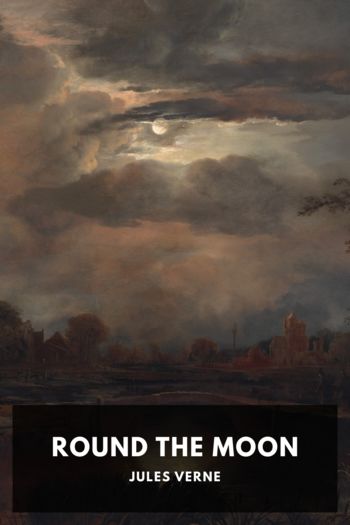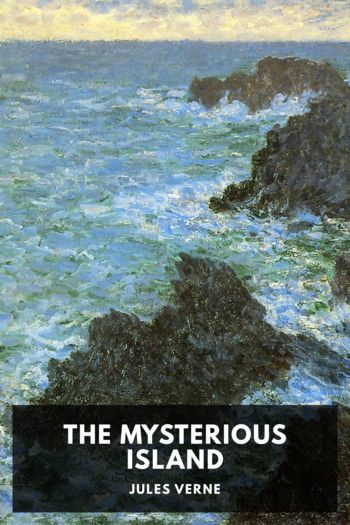Round the Moon, Jules Verne [e novels to read online .txt] 📗

- Author: Jules Verne
Book online «Round the Moon, Jules Verne [e novels to read online .txt] 📗». Author Jules Verne
“What are we looking at now?” asked Michel.
“At the northern portion of the Sea of Clouds,” answered Barbicane. “We are too far off to make out its nature. Are those plains composed of dry sand, as the first astronomers believed? Or are they only immense forests, according to the opinion of Mr. Waren de la Rue, who grants a very low but very dense atmosphere to the moon? We shall find that out later on. We will affirm nothing till we are quite certain.”
“This Sea of Clouds is rather doubtfully traced upon the maps. It is supposed that this vast plain is strewn with blocks of lava vomited by the neighbouring volcanoes on its right side, Ptolemy, Purbach, and Arzachel. The projectile was drawing sensibly nearer, and the summits which close in this sea on the north were distinctly visible. In front rose a mountain shining gloriously, the top of which seemed drowned in the solar rays.”
“That mountain is—?” asked Michel.
“Copernicus,” answered Barbicane.
“Let us have a look at Copernicus,” said Michel.
This mountain, situated in north latitude 9°, and east longitude 20°, rises to a height of nearly 11,000 feet above the surface of the moon. It is quite visible from the earth, and astronomers can study it with ease, especially during the phase between the last quarter and the new moon, because then shadows are thrown lengthways from east to west, and allow the altitudes to be taken.
Copernicus forms the most important radiating system in the southern hemisphere, according to Tycho Brahe. It rises isolated like a gigantic lighthouse over that of the Sea of Clouds bordering on the Sea of Tempests, and it lights two oceans at once with its splendid rays. Those long luminous trails, so dazzling at full moon, made a spectacle without an equal; they pass the boundary chains on the north, and stretch as far as the Sea of Rains. At 1 a.m., terrestrial time, the projectile, like a balloon carried into space, hung over this superb mountain.
Barbicane could perfectly distinguish its chief features. Copernicus is comprehended in the series of annular mountains of the first order in the division of the large amphitheatres. Like the mountains of Kepler and Aristarchus, which overlook the Ocean of Tempests, it appears sometimes like a brilliant point through the pale light, and used to be taken for a volcano in activity. But it is only an extinct volcano, like those on that side of the moon. Its circumference presented a diameter of about twenty-two leagues. The glasses showed traces of stratifications in it produced by successive eruptions, and its neighbourhood appeared strewn with volcanic remains, which were still seen in the crater.
“There exist,” said Barbicane, “several sorts of amphitheatres an the surface of the moon, and it is easy to see that Copernicus belongs to the radiating class. If we were nearer it we should perceive the cones which bristle in the interior, and which were formerly so many fiery mouths. A curious arrangement, and one without exception on the lunar disc, is presented on the interior surface of these amphitheatres, being notably downward from the exterior plane, a contrary form to that which terrestrial craters present. It follows, therefore, that the general curvature at the bottom of these amphitheatres gives us fear of an inferior diameter to that of the moon.”
“What is the reason of this special arrangement?” asked Nicholl.
“It is not known,” answered Barbicane.
“How splendidly it shines!” said Michel. “I think it would be difficult to see a more beautiful spectacle!”
“What should you say, then,” answered Barbicane, “if the chances of our journey should take us towards the southern hemisphere?”
“Well, I should say it is finer still,” replied Michel Ardan.
At that moment the projectile hung right over the amphitheatre. The circumference of Copernicus formed an almost perfect circle, and its steep ramparts were clearly defined. A second circular enclosure could even be distinguished. A grey plain of wild aspect spread around on which every relief appeared yellow. At the bottom of the amphitheatre, as if in a jewel-case, sparkled for one instant two or three eruptive cones like enormous dazzling gems. Towards the north the sides of the crater were lowered into a depression which would probably have given access to the interior of the crater.
As they passed above the surrounding plain Barbicane was able to note a large number of mountains of slight importance, amongst others a little circular mountain called “Gay-Lussac,” more than twenty-three kilometres wide. Towards the south the plain was very flat, without one elevation or projection of the soil. Towards the north, on the contrary, as far as the place where it borders on the Ocean of Tempests, it was like a liquid surface agitated by a storm, of which the hills and hollows formed a succession of waves suddenly coagulated. Over the whole of this, and in all directions, ran the luminous trails which converged to the summit of Copernicus. Some had a width of thirty kilometres over a length that could not be estimated.
The travellers discussed the origin of these strange rays, but they could not determine their nature any better than terrestrial observers.
“Why,” said Nicholl, “may not these rays be simply the spurs of the mountains reflecting the light of the sun more vividly?”
“No,” answered Barbicane, “if it were so in certain conditions of the moon they would throw shadows, which they do not.”
In fact, these rays only appear when the sun is in opposition with the moon, and they disappear as soon as its rays become oblique.
“But what explanation of these trails of light have been imagined?” asked Michel, “for I cannot believe that savants would ever stop short for want of explanation.”
“Yes,” answered Barbicane, “Herschel has uttered an opinion, but he does not affirm it.”
“Never mind; what is his opinion?”
“He thought that these rays must be streams of cold lava which shone when the sun struck them normally.”
“That may be true, but nothing is less certain. However,





Comments (0)